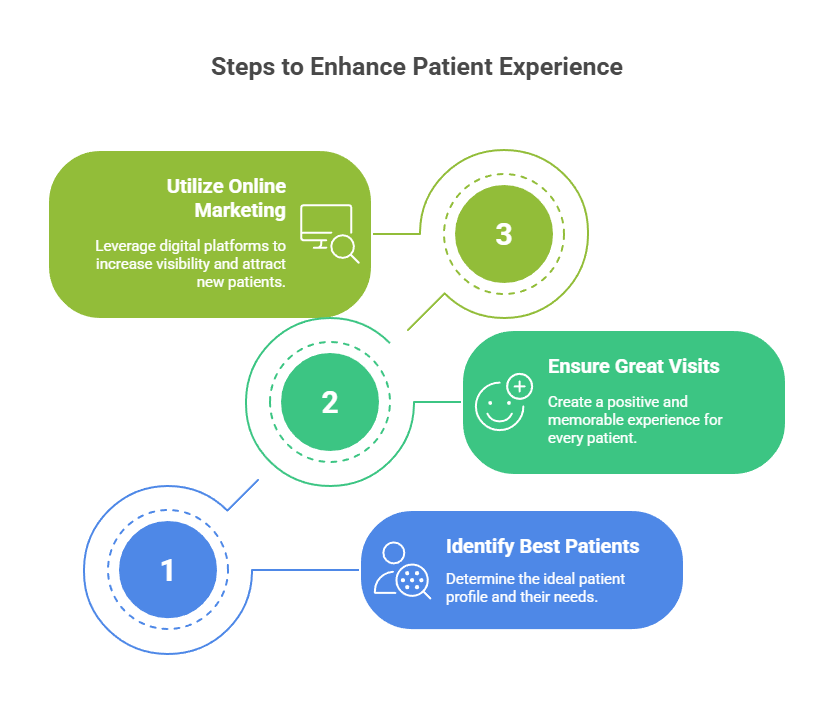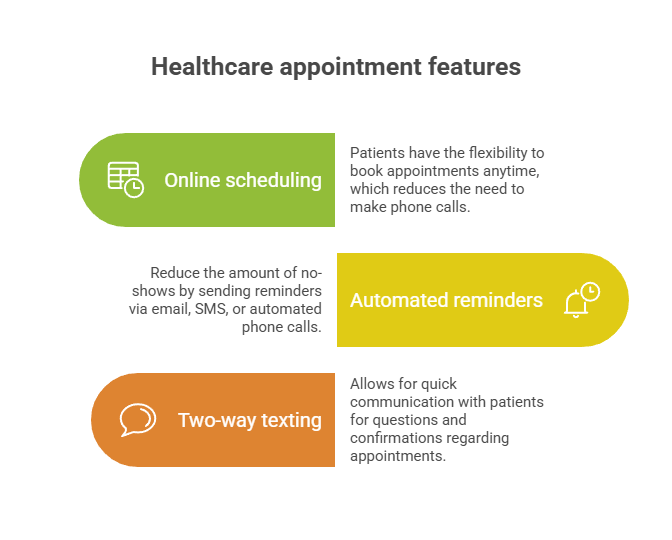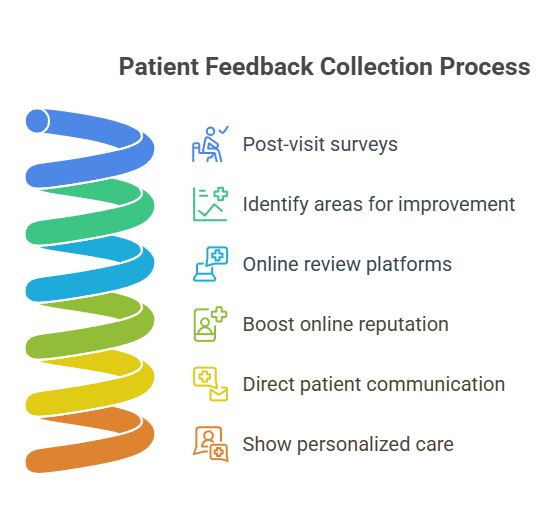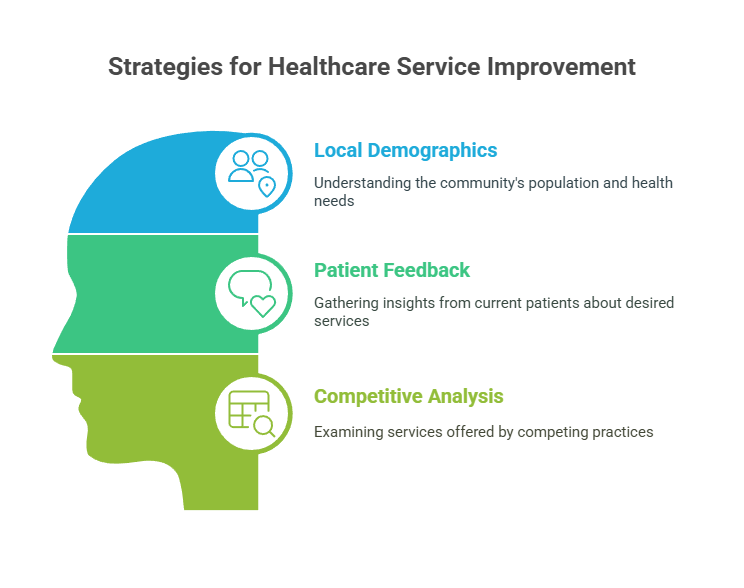- Dr. Vida Puodziunas
- Category - Growth Strategies

Want to get more patients in your medical office? It’s all about using smart clinical growth strategies. This article will show you how to find new patients, make sure they have a good experience, and keep them coming back. We’ll also talk about how to use online tools and add new services to help your practice grow.

To effectively increase patient volume, it’s important to first figure out who your ideal patients are. This isn’t just about age or gender; it’s about understanding their needs, their concerns, and what motivates them to seek medical care. By knowing who your audience is, you can adapt your offerings and communication to appeal to the right individuals.
Start by creating detailed profiles of the patients you want to attract. Think about more than just basic demographics. Consider their lifestyle, their health goals, and even their preferred ways of getting information. Are they busy professionals who need flexible appointment times? Are they families looking for comprehensive care for all ages? Or perhaps they are individuals with specific chronic conditions seeking specialized treatment? The more specific you are, the better you can shape your approach. This process helps in medical practice advertising by making your efforts more focused. This targeting sharpens your medical practice advertising efforts, which are key components of effective clinical growth strategies.
Look at your current patient base. What do they have in common? What services do they use most often? Reviewing this data can uncover trends and insights about the patients you’re effectively reaching. This information can also highlight areas where you might be missing opportunities. For example, if you see a lot of patients from a particular neighborhood, you might want to focus your outreach efforts there. This analysis can also show you which services are most popular, helping you decide where to invest more resources.
Beyond your existing patients, it’s a good idea to look at the broader community. What are the health needs in your area? Are there specific conditions that are more common? Are there gaps in local healthcare services that your practice could fill? Surveys, focus groups, and public health data can all provide valuable insights. Understanding the local landscape helps you position your practice to meet unmet demands. This research helps position your practice to meet emerging demands—another pillar of clinical growth strategies.
Understanding your ideal patient goes beyond simple demographics. It requires a thorough understanding of their behaviors, preferences, and medical needs. By laying the groundwork for strategic planning, these insights ensure your efforts target the patients most likely to respond and thrive.
Delivering a great patient experience builds loyalty and boosts referrals, which can significantly increase patient volume. This goes beyond just good medical care; it involves all patient engagements, beginning with their first contact and extending to post-visit care.. Think about how you can make each step as smooth and reassuring as possible. It’s about creating an environment where patients feel heard, respected, and cared for, which can be a significant differentiator in a competitive healthcare landscape. The goal is to make every patient feel like they are your most important patient.

Making it easy for patients to book appointments and communicate with your practice is a big deal. Many practices still rely on phone calls, which can be a bottleneck. Consider implementing online scheduling systems. These allow patients to book at their convenience, even outside of office hours. It’s a simple change that can make a huge difference in patient satisfaction. Also, think about how you send reminders. Automated texts or emails can cut down on no-shows, which helps your schedule stay full and reduces wasted time.
When patients arrive at your office, their experience continues. The waiting room should be comfortable and welcoming. Long wait times are a common complaint, so managing them effectively is key. This might involve optimizing your scheduling process or having staff check in with patients if there’s an unexpected delay. Even small gestures, like offering Wi-Fi or a comfortable chair, can improve the overall ambiance. The goal is to make the time spent in your office as pleasant as possible, minimizing any stress or frustration.
The distinction between clinical development vs clinical operations is important here. While clinical development focuses on bringing new treatments to fruition, clinical operations is about the day-to-day running of patient care. Optimizing the patient experience falls squarely within clinical operations, requiring efficient processes and attentive staff to ensure smooth patient flow and satisfaction.

After a patient’s visit, the experience isn’t over. Follow-up calls or messages can show you care about their recovery and well-being. This is also a great time to ask for feedback. Patient feedback is gold. It tells you what you’re doing well and where you can improve. You can use surveys, online review platforms, or direct communication. Responding to feedback, especially negative feedback, shows you’re committed to getting better. This continuous loop of care and improvement helps build trust and loyalty, encouraging patients to return and recommend your practice to others. Responding to feedback, especially negative, demonstrates commitment to improvement, fostering trust and loyalty — essential elements in clinical growth strategies.
| Feedback Method | Description | Expected Outcome |
|---|---|---|
| Post-visit surveys | Short questionnaires sent after appointments | Identifies areas for improvement in service and care |
| Online review platforms | Encouraging patients to leave reviews on Google, Yelp, etc. | Boosts online reputation and attracts new patients |
| Direct patient communication | Follow-up calls or emails from staff | Shows personalized care and addresses specific concerns |
Digital marketing is a big deal for medical practices these days. It’s not just about having a website; it’s about making sure that website actually works for you. Think of your website as your main office online. It needs to be easy to use, look good, and tell people what they need to know. If it’s hard to find information or book an appointment, people will just go somewhere else. A great website is essential to building a winning digital marketing plan.
Your online presence goes beyond just your website. It includes everything from your social media profiles to online directories. Making sure all this information is correct and consistent is super important. People often search for local services, so if your address or phone number is wrong on one site, it can cause problems. It’s like having a wrong sign outside your physical office. You want to make it as easy as possible for people to find you and understand what you do. This also means having good, clear descriptions of your services and what makes your practice special.
Local SEO is all about getting your practice to show up when people in your area search for medical services. This is different from regular SEO, which is more about general searches. To improve local SEO, maintain a fully detailed and updated Google Business Profile. This includes your hours, photos, and services. Getting good reviews from patients also helps a lot, as Google sees those as a sign of a trustworthy business. You also want to make sure your website uses keywords that people in your area would search for, like “[city name] primary care” or “[city name] physical therapy.”
Focusing on local search terms and maintaining an active, accurate Google Business Profile can significantly boost your visibility to potential patients in your immediate area. This direct approach helps connect your practice with individuals actively seeking medical care nearby.
Here are some key steps for local SEO:
Social media isn’t just for sharing personal updates; it’s a powerful tool for connecting with patients and building your practice’s reputation. You can share helpful health tips, updates about your practice, or even patient success stories (with permission, of course). The goal is to be a trusted source of information and to show the human side of your practice. Content marketing, like writing blog posts or creating videos, also helps.
When you provide useful information, people see you as an authority in your field. It creates confidence that encourages more patients to choose your practice. For example, a blog post about “Understanding Your Annual Check-up” can attract people looking for that kind of information, and then they might consider your practice for their care. Digital marketing for medical practices is a continuous effort that requires consistent attention to these various channels.
It’s not enough to just put out content and hope for the best. You need to know what’s working and what’s not. Use tools like Google Analytics to monitor traffic, user behavior, and conversion rates. This data-driven approach allows you to refine your clinical growth strategies continuously for optimal results. Are they filling out appointment forms? Are they spending time on your service pages?
This data helps you understand if your efforts are paying off and where you might need to make changes. For example, if a lot of people are visiting a certain page but not taking the next step, you might need to make the call to action clearer. Regularly reviewing these numbers helps you refine your strategies and get better results over time.
| Metric | Description | Importance |
|---|---|---|
| Website Traffic | Website visitor count | Indicates overall reach |
| Conversion Rate | Rate at which visitors engage with your call to action | Shows effectiveness of calls to action |
| Local Search Rank | Your position in local search results | Directly impacts local visibility |
| Social Media Reach | Unique views on your content | Measures brand awareness on social platforms |
To grow patient numbers, it’s smart to look at what services your practice currently provides and consider adding new ones. This isn’t just about doing more of the same; it’s about finding gaps in what’s available locally and filling them. When you offer something unique or in high demand, you naturally draw in more people.

Finding out what your community needs but isn’t getting is a key step in expanding your services effectively. This means doing some research to see where the opportunities are. Maybe there’s a lack of specialized care, or perhaps certain procedures are hard to access. Once you know what’s missing, you can plan to introduce those services.
Bringing in new technologies and treatments can make your practice stand out. Patients often look for modern, efficient care. For example, if you’re a dental practice, adding CAD/CAM systems for same-day crowns can be a big draw. This shows you’re committed to convenience and up-to-date methods. It’s not just about having the latest gadgets; it’s about how those tools improve the patient experience and outcomes.
When considering new services, it’s important to think about the full picture. This includes not only the equipment and training needed but also how these new services fit into your existing operations. A smooth integration means better care for patients and less stress for your team.
Sometimes, the best way to expand is to go where the patients are. Mobile clinics or outreach programs can reach people who might not otherwise visit your practice. This could involve setting up a temporary clinic at a community event, visiting local businesses, or even offering home visits for certain services. This approach can open up entirely new patient groups and build strong community ties.
| Program Type | Target Audience | Potential Benefit |
|---|---|---|
| Mobile Clinic | Underserved Areas | Increased Access to Care |
| Corporate Wellness | Local Businesses | New Patient Referrals |
| School Screenings | Children/Families | Community Engagement |
When you add new services, your team needs to be ready. Equipping your team through training ensures they’re ready to deliver quality care for expanding services. This might mean sending staff to workshops, bringing in trainers, or developing in-house programs. With strong training, your staff feels assured, leading to better outcomes for patients and smoother service integration.
Track key performance indicators (KPIs) such as new patient acquisition, retention rates, referral sources, patient satisfaction, and no-show rates. Use this data to make informed adjustments in your clinical growth strategies.
To truly boost patient volume, you have to keep a close eye on how things are going. It’s not enough to just put new plans in place; you need to know if they’re actually working. This means regularly looking at your data and being ready to change things up if they aren’t producing the results you want. Think of it like a continuous loop: plan, do, check, adjust. This approach helps you stay agile and make smart decisions based on real information.
Before you can measure progress, you need to know where you’re starting from. This involves gathering data on your current patient volume, referral sources, patient retention rates, and even things like average wait times. Once you have this baseline, you can set clear, measurable goals for improvement. For example, if your current patient volume is 100 new patients a month, you might aim for 120 new patients within the next quarter. Set goals that are achievable yet still challenge you to grow. It’s also important to consider different healthcare operational analytics to get a full picture.
Monitoring specific KPIs is how you track your progress toward your goals. These indicators give you a snapshot of your practice’s health and show you what’s working and what isn’t. Here are some important KPIs to watch:
Regularly reviewing these metrics helps you understand the impact of your growth strategy examples. It’s not just about collecting numbers; The key is to understand how those metrics reflect on your practice and the experience of your patients. Using data in this way is essential for smart, informed decision-making.
Once you’ve identified areas that need improvement, you need a plan for making changes. This could involve adjusting your marketing campaigns, refining your patient intake process, or even re-evaluating your service offerings. For instance, if your patient satisfaction scores are low, you might need to train staff on communication skills or streamline check-in procedures. If a particular marketing channel isn’t performing, you might shift your budget to a more effective one. A good clinical strategy manager understands that flexibility is important. Continuous tracking and improvement drive sustained growth and ensure your practice meets changing patient and market needs. It’s a dynamic process, not a one-time fix. This is a core part of any effective clinical research strategies.
It’s super important to keep an eye on your progress and be ready to change your plans quickly. This way, you can always do your best. Want to learn more about how we can help you stay on top of your goals? Visit our website today!
So, there you have it. Getting more patients isn’t just about doing one big thing; it’s a bunch of smaller steps that add up. Increasing patient volume is a series of smart, consistent clinical growth strategies rather than a one-time fix. Think about what your practice does well, and then pick a few ideas from this article to try out. Start small, see what works, and don’t be afraid to change things if they aren’t quite right. It’s like repairing a bike on your own—things can get messy fast, but eventually, you figure out what makes it go. The main thing is to keep trying and adjust as you go. That’s how you really get things moving.
To bring in more patients, you need to know who you want to help and what they need. Then, make sure every step of their visit, from calling to leaving, is smooth and pleasant. Use online tools like Google and social media to reach more people. Think about offering new services that patients are looking for. And always keep an eye on what’s working and what’s not, so you can make changes as needed.
Making patients happy means making their whole visit easy and stress-free. This starts with how they find you online, how quickly you answer the phone, and how friendly your staff is. Make sure your office feels welcoming. When patients have a good experience, they’re more likely to come back and tell their friends about you.
It’s super important to keep track of things like how many new patients you’re getting, where they’re coming from, and if they’re coming back. This helps you see if your plans are working. If things aren’t working, you can swiftly adjust your strategy. This way, you don’t waste time or money on things that aren’t helping your practice grow.
If you have any additional questions or if you would like to see if we could help your practice, feel free to contact me at Dr.Vida Puodziunas 813-906-0477.